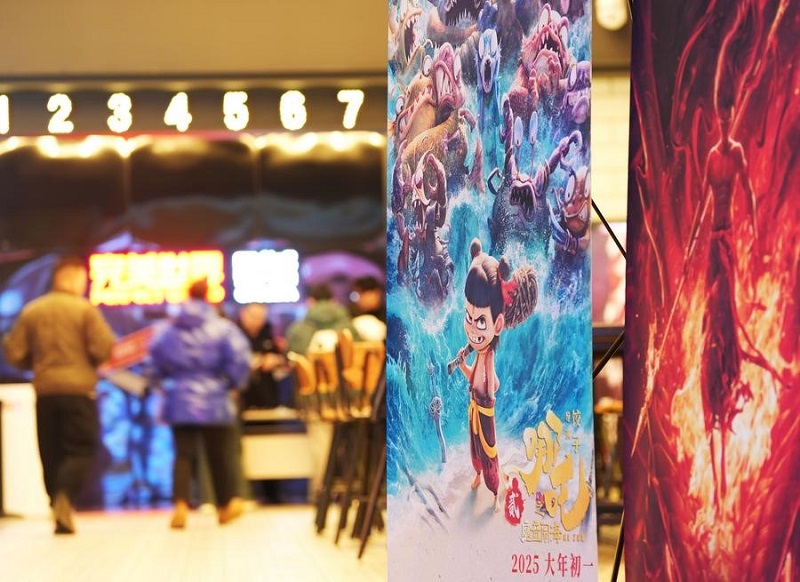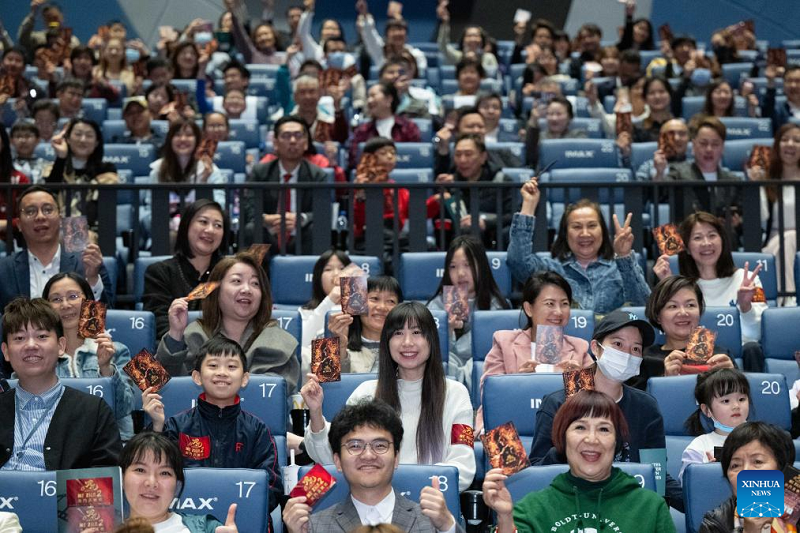As animated blockbuster “Ne Zha 2” and the video game “Black Myth: Wukong” become all the rage globally, Chinese culture is in the international spotlight again.
Since its release in January 29, Chinese animated film “Ne Zha 2” has been making history. It entered the list of the all-time global box office top 10 only 20 days later, with ticket sales surpassing RMB 12 billion. It is also the world’s highest-grossing animated movie of all time, and the highest-grosser in a single market. IMDb gave it an 8.3 rating as of February 20, reflecting its universal appeal.

Posters of the animated feature "Ne Zha 2" are pictured at a cinema in Shenyang, northeast China's Liaoning Province, Feb. 6, 2025. (Xinhua/Li Gang)
“Ne Zha 2” or “Ne Zha: The Demon Child Conquers the Dragon King,” the story of a child deity with supernatural powers, is a sequel to the 2019 hit movie “Ne Zha: The Demon Child Comes into the World.” They have enthralled audiences, both at home and abroad, with their sparkling dialogue, impressive animation technology, and over and above everything else, the aesthetic presentation of an ancient mythological story rooted deeply in Chinese culture.
“It not only showcases the strong power of Chinese animation after its rise, but also demonstrates the infinite possibilities of traditional Chinese mythology in the modern context,” an IMDB review reads. On Reddit, a user commented, “Chinese historical/fantasy/cultural movies are second to none in storytelling. Their mix of fantasy with martial arts and religion is peak entertainment.” On various social media platform, #Ne Zha2 is trending, described as “visually stunning” and “emotionally powerful.”
The story of Ne Zha, a folk religion deity in China, has been adapted for the silver screen many times, including the 1979 sensation “Ne Zha Conquers the Dragon King,” which established the most classic image of Ne Zha in people’s mind. The new edition owes its success to the earlier films that introduced Western audiences to traditional Chinese cultural elements and whetted their appetite for more.
“Ne Zha 2” presents a diversity of Chinese cultural elements, ranging from Buddhism, Taoism, and traditional Chinese art to mythology and history. The Sanxingdui culture, a major Bronze Age culture excavated in southwest China that possessed extremely sophisticated smelting technology and created uniquely designed artifacts has a major contribution to “Ne Zha 2.” The Barrier Beasts in the film, who defend the boundary, are inspired by the bronze heads found in the Sanxingdui Ruins with a gold mask and bulging eyes.

Audience show the tickets at the premiere of "Ne Zha 2" in Macao, south China, Feb. 19, 2025. Chinese mainland's animated blockbuster "Ne Zha 2" premiered on Wednesday in Macao and was scheduled to officially hit Macao theaters on Saturday. (Xinhua/Cheong Kam Ka)
According to Yang Yu, also known as Jiaozi, director of the film, whether Chinese films can become international hits hinges on “whether the script, the story and its characters can move audiences worldwide.” Ne Zha, the boy hero’s rebellious spirit, which drives him to fight powerful dictators and destiny has a strong universal appeal, making an old story resonate with the universal topics of identity recognition, pursuit of social justice, and resilience. “Ne Zha’s struggle mirrors my own battles against prejudice,” a U.S. viewer told Xinhua.
The cherry on top is undoubtedly the stunning visual effects, a sector once dominated by Hollywood. Yang, a former pharmacy student-turned-animation producer, established a reputation as a perfectionist, creating a stunning visual feast aided by the hi-tech that shocked the entire film industry.
Over 130 animation studios chipped in with nearly 10,000 special effect elements, showing the impressive progress of China’s animation industry. “The film showcases the collaborative power of China’s creative ecosystem and heralds an upgrade in both the film industry and its aesthetic standards,” observed Chen Xuguang, director of the Institute of Film, Television and Theatre at Peking University.
As the film continues to take the world by storm, some Western media outlets have sought to present it as nationalistic, aggressively so, with headlines like “‘Captain America must die in China’: Nationalism fuels Ne Zha 2 fans.” However, that is an injustice to Chinese filmgoers. While they loved the film, they also appreciate great fantasy films from other countries. The box office figures show the popularity of “Ne Zha 2,” figures which cannot be faked.
The popularity of “Ne Zha 2” is reminiscent of the immense craze for the video game “Black Myth: Wukong,” which too is an inventive packaging of Chinese cultural elements as traditional architecture, sculpture, murals and myths, knit together with high technology. The success of “Black Myth: Wukong,” even made several scenic spots in north China’s Shanxi Province, the prototypes of many scenes for the video game, become hot tourist destinations.
“Ne Zha 2” and “Black Myth: Wukong,” together with other Chinese films like “Creation of the Gods II: Demon Force,” based on the Chinese novel Fengshen Yanyi, or The Investiture of the Gods, aroused global interest in Chinese art and culture. Those masterworks accentuate the enduring appeal of the ancient culture and the potential for Chinese stories to captivate global audiences.